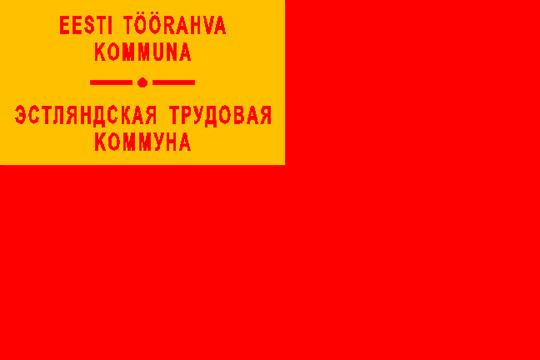Government Socialist republic Founded 1918 | Languages EstonianRussian Established 29 November 1918 | |
 | ||
The Commune of the Working People of Estonia (Estonian: Eesti Töörahva Kommuun, initially Eesti Töörahwa Kommuuna; Russian: Эстляндская трудовая коммуна, ЭТК or ETK) was an unrecognised government claiming the Bolshevik-occupied parts of Republic of Estonia as its territories during the Estonian War of Independence and the Russian Civil War.
Contents
Establishment and fall
The Commune was established in Narva on 29 November 1918, a day after its conquest by the Red Army. The Soviet authorities attempted to portray the offensive as a civil war but there was a lack of Estonian communists in the ranks of the occupation army and the so-called Estonian rifle regiments were in fact composed of Russians and other nationalities. It was chaired by Jaan Anvelt for the duration of its existence. Within areas of their control, the Commune closed churches, nationalised industry and the banks and outlawed representatives of the Provisional Government.
The Russian offensive was initially successful and eventually reached as far as 34 kilometres from Tallinn. However, a counter-offensive begun on 7 January 1919 by the Estonian People's Force (Rahvavägi) under Commander-in-Chief Johan Laidoner eventually drove the Red Army out of Estonia, with international military aid primarily from the British Empire. The Commune was thus rendered defunct, claiming a government in exile in Pskov, then Luga and finally, from 17 May 1919, in Staraya Russa.
International recognition
The Russian Socialist Federative Soviet Republic (RSFSR) formally recognised the ETK on 7 December 1918 and remained the only government to do so. At that time, Soviet Russia was itself not internationally recognised. One of the first international treaties recognising Russia's Soviet government as legitimate was the Treaty of Tartu concluding the Estonian War of Independence in 1920.
Massacres
The regime instituted a dictatorial reign of terror. The terror was staged in two waves, the first from October 1917 to February 1918 and a second more brutal wave from November 1918 to January 1919. A considerable number of people were arrested in Tartu in December 1919 and a number of German estate owners were shot on the frozen river on January 9, 1919. Just before Tartu was liberated the Communists staged a blood bath in the basement of a town bank, among their victims were Bishop Platon, the priest Sergei Florinski and the pastor Traugott Hahn. Over 500 people lost their lives.
Members of the Commune
Soviet authorities executed most of the members during the Great Purge.
